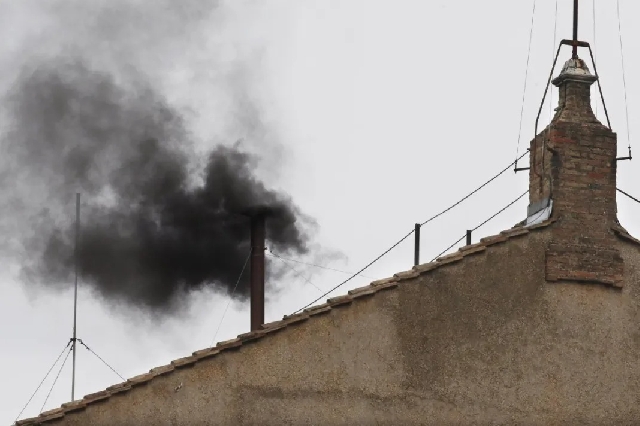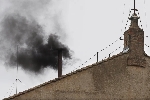Black smoke signals no pope elected in first conclave vote
 Black smoke
Black smoke
Black smoke billowed from the chimney of the Sistine Chapel on Wednesday evening, signaling an inconclusive first vote by cardinals locked in the chapel in a conclave to elect a new pope to guide the Roman Catholic Church.
Thousands of faithful gathered in St. Peter’s Square, waiting for smoke to pour from a narrow flue on the roof of the chapel at the end of a day rich in ritual and pageantry, with prelates praying for divine guidance in their secret ballot.
The crowds had to be patient, as it took longer than expected for the smoke to appear, more than three hours after the start of the conclave. This was an hour longer than it took for smoke to be seen after the first vote in the 2013 conclave that picked the late Pope Francis.
When a pope is chosen, white smoke will emerge, but this was not expected on Wednesday—a pontiff has not been picked on the first day of a conclave in modern times.
However, some cardinals said this week that they hoped to wrap things up by Thursday or Friday, to show the Church can remain unified after the often divisive 12-year papacy of Francis, who died last month.
The 133 cardinal electors, all under the age of 80, will spend the night secluded in one of two Vatican guesthouses, where they can continue their deliberations in a more informal setting before returning to the chapel on Thursday morning.
Following Wednesday’s single round of voting, the red-hatted “princes of the Church” will hold two votes in the morning session and two in the afternoon, continuing in the coming days until one man has secured a majority of at least two-thirds—89 cardinals this time around.
Their only communication with the outside world will be the smoke from the chimney as they burn their completed ballot papers mixed with special chemicals—black when a voting session ends with no result, white when a pontiff is elected.
Modern papal conclaves are typically short. The 2013 conclave lasted just two days, as did the 2005 conclave that picked his predecessor, Benedict XVI
In recent days, cardinals have offered different assessments of what they are looking for in the next pontiff, who will lead the 1.4-billion-member Church.
While some have called for continuity with Francis’ vision of greater openness and reform, others have said they want to turn the clock back and embrace older traditions. Many have indicated they want a more predictable, measured pontificate.
‘GOOD OF THE CHURCH’
In a sermon ahead of the conclave, Italian Cardinal Giovanni Battista Re, who at 91 is too old to take part in the vote, told his fellow prelates they must set aside “every personal consideration” in choosing the new pontiff and keep in mind “only … the good of the Church and humanity.”
He also suggested that the next pope must respect diversity within the Church. “Unity does not mean uniformity, but a firm and profound communion in diversity,” he said.
Some ultra-conservatives had branded Francis a heretic, accusing him of being too welcoming to the LGBT community, too accommodating to Protestants and Muslims, and too open on a range of topics, including offering communion to the divorced.
No clear favourite has emerged, although Italian Cardinal Pietro Parolin and Filipino Cardinal Luis Antonio Tagle are considered front-runners.
However, if it quickly becomes obvious that neither can win, votes are likely to shift to other contenders, with the electors possibly coalescing around geography, doctrinal affinity, or common languages.
Other potential candidates include France’s Jean-Marc Aveline, Hungary’s Peter Erdo, American Robert Prevost, and Italy’s Pierbattista Pizzaballa.
A record 133 cardinals from 70 countries entered the Sistine Chapel, up from 115 from 48 nations in the last conclave in 2013—growth that reflects efforts by Francis during his 12-year reign to extend the geographical reach of the Church.
Among their considerations will be whether to select a pope from the Global South, where congregations are growing—as they did in 2013 with Francis from Argentina—or return the reins to Europe, or even pick the first U.S. pope.
Latin chants and organ music accompanied the cardinals as they processed into the frescoed Sistine Chapel before the conclave began, with Michelangelo’s depiction of Christ delivering the Last Judgment dominating the 500-year-old room.
They laid their hands on the Gospels, taking a vow of secrecy not to divulge anything about their gathering.
Archbishop Diego Ravelli, the Vatican’s master of ceremonies, then pronounced the Latin command “Extra omnes!” (Everyone out!), telling those not involved in the gathering to leave the room, as the chapel’s heavy wooden doors slammed shut on the outside world.
There is not meant to be any discussion during the voting sessions, but past experience suggests there will be plenty of covert campaigning during breaks and meals, as the names of papabili rise and fall in successive ballots.
Source: Reuters
Trending World

Vietnam Gas President boldly slams Kenya's poor leadership
15:23
Trump says he won't seek a third term
02:02
Peru kidnapping leaves 13 dead in gold mine
01:49
India seeks to stop auction of jewels linked to Buddha remains
17:06
Sudan paramilitary attacks leave key city without power
16:02
Voting for new Pope set to begin with cardinals entering secret conclave today
09:28
Black smoke signals no pope elected in first conclave vote
03:29



